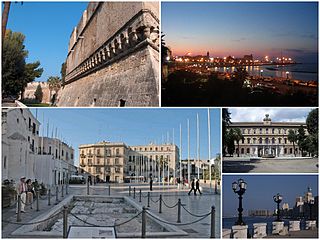
Bari is the capital city of the Metropolitan City of Bari and of the Apulia region, on the Adriatic Sea, southern Italy. It is the second most important economic centre of mainland Southern Italy after Naples. It is a port and university city, as well as the city of Saint Nicholas. The city itself has a population of 315,284 inhabitants, over 116 square kilometres (45 sq mi), while the urban area has 750,000 inhabitants. The metropolitan area has 1.3 million inhabitants.
Mustard gas or sulfur mustard is any of several chemical compounds that contain the chemical structure SCH2CH2Cl. In the wider sense, compounds with the substituent SCH2CH2X and NCH2CH2X are known as sulfur mustards and nitrogen mustards (X = Cl, Br), respectively. Such compounds are potent alkylating agents, which can interfere with several biological processes. Also known as mustard agents, this family of compounds are infamous cytotoxic and blister agents with a long history of use as chemical weapons. The name mustard gas is technically incorrect: the substances, when dispersed, are often not gases but a fine mist of liquid droplets. Sulfur mustards are viscous liquids at room temperature and have an odor resembling mustard plants, garlic, or horseradish, hence the name. When pure, they are colorless, but when used in impure forms, such as in warfare, they are usually yellow-brown. Mustard gases form blisters on exposed skin and in the lungs, often resulting in prolonged illness ending in death. The typical mustard gas is the organosulfur compound called bis(2-chloroethyl) sulfide.

Chemical warfare (CW) involves using the toxic properties of chemical substances as weapons. This type of warfare is distinct from nuclear warfare, biological warfare and radiological warfare, which together make up CBRN, the military acronym for chemical, biological, radiological, and nuclear, all of which are considered "weapons of mass destruction" (WMDs), a term that contrasts with conventional weapons.

The use of toxic chemicals as weapons dates back thousands of years, but the first large-scale use of chemical weapons was during World War I. They were primarily used to demoralize, injure, and kill entrenched defenders, against whom the indiscriminate and generally very slow-moving or static nature of gas clouds would be most effective. The types of weapons employed ranged from disabling chemicals, such as tear gas, to lethal agents like phosgene, chlorine, and mustard gas. This chemical warfare was a major component of the first global war and first total war of the 20th century. The killing capacity of gas was limited, with about 90,000 fatalities from a total of 1.3 million casualties caused by gas attacks. Gas was unlike most other weapons of the period because it was possible to develop countermeasures, such as gas masks. In the later stages of the war, as the use of gas increased, its overall effectiveness diminished. The widespread use of these agents of chemical warfare, and wartime advances in the composition of high explosives, gave rise to an occasionally expressed view of World War I as "the chemist's war" and also the era where weapons of mass destruction were created.

The United States is known to have possessed three types of weapons of mass destruction: nuclear weapons, chemical weapons, and biological weapons. The U.S. is the only country to have used nuclear weapons on another country, when it detonated two atomic bombs over two Japanese cities of Hiroshima and Nagasaki during World War II. It had secretly developed the earliest form of the atomic weapon during the 1940s under the title "Manhattan Project". The United States pioneered the development of both the nuclear fission and hydrogen bombs. It was the world's first and only nuclear power for four years, from 1945 until 1949, when the Soviet Union produced its own nuclear weapon. The United States has the second-largest number of nuclear weapons in the world, after the Russian Federation.
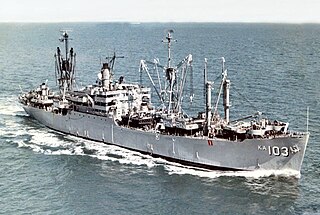
Amphibious cargo ships were U.S. Navy ships designed specifically to carry troops, heavy equipment and supplies in support of amphibious assaults, and to provide naval gunfire support during those assaults. A total of 108 of these ships were built between 1943 and 1945—which worked out to an average of one ship every eight days. Six additional AKAs, featuring new and improved designs, were built in later years. They were originally called Attack Cargo Ships and designated AKA. In 1969, they were renamed as Amphibious Cargo Ships and redesignated LKA.

Sardasht is a city in the Central District of Sardasht County, West Azerbaijan province, Iran, and serves as capital of the county.
USS Venus (AK-135) was a Crater-class cargo ship in the service of the United States Navy in World War II. Originally liberty ship SS William Williams, named after William Williams, a signer of the Declaration of Independence, it was taken over by the Navy after being damaged in a torpedo attack and renamed after the planet Venus. It was the only ship of the Navy to bear this name.

SS Timothy Bloodworth was a standard Liberty ship built for the United States Maritime Commission during World War II. The vessel was built by Delta Shipbuilding Company of New Orleans in 1943. She was named in honor of Timothy Bloodworth, an American teacher who made muskets and bayonets during the American Revolutionary War, then went on to become a statesman in North Carolina.
SS V.A. Fogg was a modified T2 tanker built in 1943, as SS Four Lakes. After service in World War II, she was eventually sold into private ownership. She was renamed V.A. Fogg in 1971, shortly before she exploded and sank off Freeport, Texas.
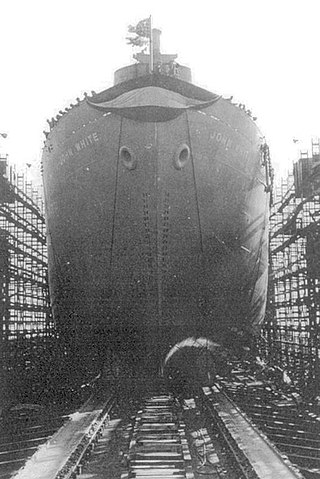
USS Menkar (AK-123) was a Crater-class cargo ship, converted from a Liberty Ship, commissioned by the U.S. Navy for service in World War II. She was first named after John White, a settler among those who sailed with Richard Grenville, to present-day North Carolina, in 1585, to found the Roanoke Colony. White acted as artist and mapmaker to the expedition. He became the governor, in 1587, of the colony, and his granddaughter, Virginia Dare, was the first English child born in the Americas. She was renamed and commissioned after Menkar, the second-brightest star in the constellation of Cetus. She was responsible for delivering troops, goods and equipment to locations in the war zone.

Operation CHASE was a United States Department of Defense program for the disposal of unwanted munitions at sea from May 1964 until the early 1970s. Munitions were loaded onto ships to be scuttled once they were at least 250 miles offshore. While most of the sinkings involved conventional weapons, four of them involved chemical weapons. The disposal site for the chemical weapons was a three-mile (5 km) area of the Atlantic Ocean between the coast of the U.S. state of Florida and the Bahamas. The CHASE program was preceded by the United States Army disposal of 8,000 short tons of mustard and lewisite chemical warfare gas aboard the scuttled SS William C. Ralston in April 1958. These ships were sunk by having Explosive Ordnance Disposal (EOD) teams open seacocks on the ship after they arrived at the disposal site. The typical Liberty ship sank about three hours after the seacocks were opened.
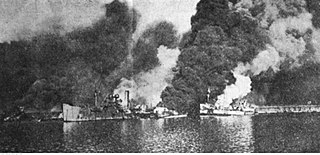
The air raid on Bari was an air attack by German bombers on Allied forces and shipping in Bari, Italy, on 2 December 1943, during World War II. 105 German Junkers Ju 88 bombers of Luftflotte 2 achieved surprise and bombed shipping and personnel operating in support of the Allied Italian Campaign, sinking 27 cargo and transport ships, as well as a schooner, in Bari harbour.
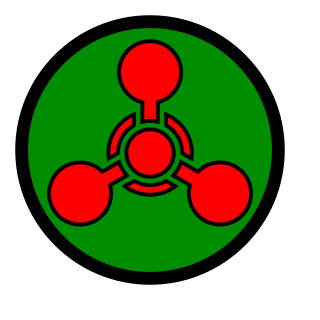
A chemical weapon (CW) is a specialized munition that uses chemicals formulated to inflict death or harm on humans. According to the Organisation for the Prohibition of Chemical Weapons (OPCW), this can be any chemical compound intended as a weapon "or its precursor that can cause death, injury, temporary incapacitation or sensory irritation through its chemical action. Munitions or other delivery devices designed to deliver chemical weapons, whether filled or unfilled, are also considered weapons themselves."

SS El Estero was a ship filled with ammunition that caught fire at dockside in New York Harbor in 1943, but was successfully moved away and sunk by the heroic efforts of tug boats and fireboats, averting a major disaster.
The United States chemical weapons program began in 1917 during World War I with the creation of the U.S. Army's Gas Service Section and ended 73 years later in 1990 with the country's practical adoption of the Chemical Weapons Convention. Destruction of stockpiled chemical weapons began in 1985 and is still ongoing. The U.S. Army Medical Research Institute of Chemical Defense (USAMRICD), at Aberdeen Proving Ground, Maryland, continues to operate.
Chemical weapons have been a part of warfare in most societies, although their use has been particularly controversial since the 20th century.

SS Hobart Baker was a Liberty ship built for the United States Maritime Commission during World War II. The ship was named in honor of Hobart Baker. Hobart "Hobey" Baker (1892–1918) was an American amateur athlete and is considered the first American star in ice hockey. He was also an American football player. The ship was assigned by the War Shipping Administration to General Steamship Company of San Francisco who operated it throughout World War II. Hobart Baker was laid down on 16 April 1943, launched on 12 May 1943 and completed on 24 May 1943, with the hull No. 1114 as part of the Emergency Shipbuilding Program, built is 38 days.
Lieutenant-Colonel Stewart Francis Alexander was an American medical doctor from New Jersey and an expert on chemical warfare who was dispatched to attend the patients following the Air raid on Bari.
SS Testbank was a British cargo steamship that was built in England in 1937 and sunk with heavy loss of life in the air raid on Bari in December 1943. She was the first of two Bank Line cargo ships to be called Testbank. The second was a motor ship that was built in 1961, sold and renamed in 1978, and scrapped in 1987.











